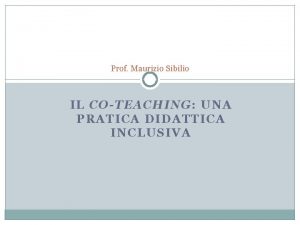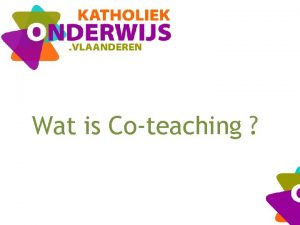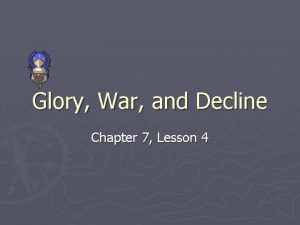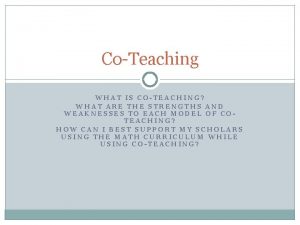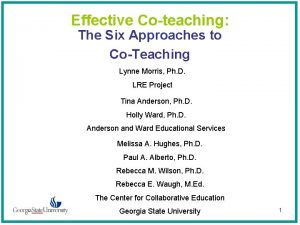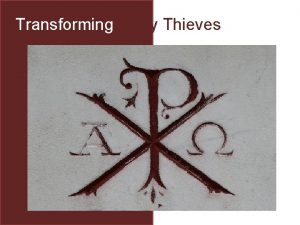Coteaching and All Its Glory Janel Cypert M


























- Slides: 26

Co-teaching and All Its Glory Janel Cypert, M. Ed. /School Support Specialist

Agenda • What do you know about co-teaching? • The research and the law behind co-teaching • Types of co-teaching models • Application • Questions/Concerns

Let’s start with a game…What do you know about co-teaching?

So TRUE/So FALSE Research supports that co-teaching has significantly improved student outcomes.

SO TRUE! �Students with disabilities need access to the same curriculum �It must be the same rigor; they are tested the same as their peers �It is a preferred service delivery option (Huberman, Navo, & Parrish, 2012; Silverman, Hazlewood, & Cronin, 2009; Walsh, 2012) �It has significantly improved student outcomes (eg. , Benningfield, 2012)

A paraprofessional is a co-teacher.

SO FALSE • A great resource in the classroom for students and the teacher • Cannot provide initial instruction • Can work with students in small group or 1: 1

Co-teachers must have a shared planning…

SO FALSE It is ideal to have the same planning time, but resources and scheduling will guide the common planning: • Face to Face • Substitute Covers • Electronic Lesson Planning • On-the-Spot Planning

The Special Education teacher is in the classroom to help their students.

So TRUE…So FALSE • They are in the general education classroom to provide delivery of specifically designed instruction(SDI): academic, behavior, and social support • They are a team member there to help all students • The general education teacher contributes to SDI

What’s So Special About Co-Teaching? • It is supported in federal law, research, and by parents (Villa, Thousand, & Nevin, 2004) • It provides an increased education opportunity for all students: a sense of community • It’s an opportunity for colleagues to collaborate and grow professionally • Labels of “those” students are diminished; We change our vocabulary to “our” students • Increased instructional time • Research-proven strategies are used • Student attitudes about themselves improve: academic and social

So…what do we want to know about Co-teaching?

Types of Co-Teaching • Station Teaching • Parallel Teaching • Teaming

Station Teaching • Students are arranged in three groups • Two groups work with one teacher while one group works independently • Students rotate stations • Provides an opportunity for teachers to work with all students in the classroom

Station Teaching: Benefits • The ability to group students by need • Meets the instructional goals of the individual student • Provides an opportunity for remediation, intervention, or enhancement activities • Effective classroom management tool • Students are engaged in their learning

Parallel Teaching • Class is split in 2 groups • Each teacher is conducting a lesson • Each group gets the same instruction • Groups do not rotate

Parallel Teaching: Benefits • Maximizes student participation • Minimizes behavior issues • Increases instructional intensity

Teaming • Both teachers in front of the classroom • Equal roles • Both teachers are engaged in the delivery of core instruction

Teaming: Benefits • Energizing • Increase engagement factor through instructional conversations and sharing question asking • Students are attentive

5 Tips to Becoming a Strong Co-Teacher 1. “All students are our students. ” 2. Come to planning meetings prepared to maximize co-planning time. 3. Open Communication 4. Success of your class depends on the strength of your co-teaching relationship. 5. Use a variety of co-teaching models

“Inclusion is not a place, but instead a process. ”Anonymous

Application: Let’s Talk • What might co-teaching look like at your site? • When thinking about our IEP caseload. . which students would benefit from co-teaching versus direct instruction? • Is there an opportunity to provide both direct instruction and a co-teaching model? • How can we implement common planning time for general education and SPED teachers?

Questions and Answers What questions do you have? What can we share with you that is not clear? How can we help?

Resources • Friend, M. (2008). Co-Teach! A handbook for creating and sustaining effective classroom partnerships in inclusive schools. Greensboro: Marilyn Friend. • Villa, R. , Thousand, J. , & Nevin, A. (2004). A guide to coteaching: practical tips for facilitating student learning. Thousand Oaks: Corwin Press.

Contact Information Janel Cypert, M. Ed. Office of School Support Specialist 405. 521. 2841 Janel. cypert@sde. ok. gov
 榮耀神羔羊
榮耀神羔羊 Glory glory hallelujah he reigns
Glory glory hallelujah he reigns Co teaching cos'è
Co teaching cos'è Coteaching
Coteaching Hymn 647
Hymn 647 Glory glory oh god almighty
Glory glory oh god almighty Glory glory how the angels sing
Glory glory how the angels sing The yellow terror in all his glory
The yellow terror in all his glory For all the saints hymn
For all the saints hymn All glory
All glory All glory to god
All glory to god All glory to him
All glory to him It's the song of the redeemed
It's the song of the redeemed Name all the lines name all the segments name all the rays
Name all the lines name all the segments name all the rays The emigree poem analysis
The emigree poem analysis Its halloween its halloween the moon is full and bright
Its halloween its halloween the moon is full and bright Blessing and honor glory and power
Blessing and honor glory and power These beauteous forms
These beauteous forms When a train increases its velocity its momentum
When a train increases its velocity its momentum Windy snowy rainy sunny
Windy snowy rainy sunny If its square its a sonnet summary
If its square its a sonnet summary Its not easy but its worth it
Its not easy but its worth it You deserve the glory and the honor song
You deserve the glory and the honor song Spain god gold glory
Spain god gold glory God gold and glory essay
God gold and glory essay Chapter 7 lesson 4 glory, war, and decline answers
Chapter 7 lesson 4 glory, war, and decline answers What are the 4 gs of exploration
What are the 4 gs of exploration


